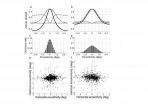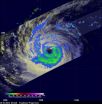(Press-News.org) Amsterdam, NL, October 16, 2012 – Little is known about oculomotor function in amblyopia, or "lazy eye," despite the special role of eye movements in vision. A group of scientists has discovered that abnormal visual processing and circuitry in the brain have an impact on fixational saccades (FSs), involuntary eye movements that occur during fixation and are important for the maintenance of vision. The results, which raise the question of whether the alterations in FS are the cause or the effect of amblyopia and have implications for amblyopia treatment, are available online in advance of publication in the November issue of Restorative Neurology and Neuroscience.
"Although FSs are of great functional significance in neural coding, visual perception, and visual task execution, their behavioral characteristics in visual and neurological disease have been rarely studied," says lead investigator Xue-Feng F. Shi, MD, PhD, of the Tianjin Key Laboratory of Ophthalmology and Visual Science, Tianjin Eye Institute, College of Clinical Ophthalmology, Tianjin Medical University, and the Department of Pediatric Ophthalmology and Strabismus, Tianjin Eye Hospital, Tianjin, China. "We carried out quantitative and detailed analysis of fixational saccades in amblyopia for the first time."
Investigators examined 28 patients with amblyopia and 28 age-matched control subjects. Using a high-speed eye-tracker, fixational eye movements of both eyes were recorded. A computerized analysis of eye-movement waveforms was developed to quantify the parameters of FSs, and a simulation model was used to explore the neural mechanism of changes in fixational saccadic performance of amblyopic eyes.
Amblyopic eyes showed fewer FSs than control eyes, but they had increased amplitudes and speed. Periods between movements were significantly longer in amblyopic eyes. FS was suppressed mainly for those with amplitudes smaller than 0.6 degrees, but was increased for those greater than 0.6 degrees. "We conclude that the change of amplitude distribution is a dominant alteration of FSs in amblyopia, while the change of other parameters is secondary. These findings should provide the necessary baseline information for future studies and should advance our understanding of the correlation between visual system impairment and eye-movement behavior," notes Dr. Shi. The simulation model suggests that an excitatory-inhibitory activity imbalance in the superior colliculus (SC) of the brain, an area involved with vision and eye movement, may explain these changes.
Dr. Shi explains that there are two possible interpretations of the study. "Altered FSs may be an effect of amblyopia, an attempt of the visual system to try to capture more information from a broader spatial domain to enhance contrast sensitivity, which is reduced in lazy eye. Or it may be the cause or a contributing factor to the original deficit, which may open up a new avenue for the research of the neural mechanisms of amblyopia that will be as different from the traditional research route as the pioneering work in visual cortex by Hubel and Wiesel (Nobel Laureates). Another issue of particular interest is whether amblyopia treatment and visual training can positively influence FS," he says. "To solve these questions will be a major step forward in our understanding of visual system and eye movement impairments which then provides a new starting point for innovative therapeutic approaches."
INFORMATION:
Abnormal involuntary eye movements in amblyopia linked to changes in subcortical regions of brain
Findings rublished in Restorative Neurology and Neuroscience
2012-10-17
ELSE PRESS RELEASES FROM THIS DATE:
Viral alliances overcoming plant defenses
2012-10-17
PULLMAN, Wash.— Washington State University researchers have found that viruses will join forces to overcome a plant's defenses and cause more severe infections.
"These findings have important implications in our ability to control these viruses", says Hanu Pappu, Sam Smith Distinguished Professor of Plant Virology and chair of WSU's Department of Plant Pathology. "Mixed infections are quite common in the field and now we know that viruses in these mixed infections are helping each other at the genetic level to overcome host defenses and possibly lead to the generation ...
New paper reveals fundamental chemistry of plasma/liquid interactions
2012-10-17
Though not often considered beyond the plasma television, small-scale microplasmas have great utility in a wide variety of applications. Recently, new developments have begun to capitalize on how these microplasmas interact with liquids in applications ranging from killing bacteria for sterilizing a surface to rapidly synthesizing nanoparticles.
An interdisciplinary collaboration between researchers at Case Western Reserve University and the University of Notre Dame has revealed a critical interaction that is occurring at this plasma-liquid interface in that the electrons ...
Immune response may link social rejection to later health outcomes
2012-10-17
No matter which way you look at it, rejection hurts. Experiencing rejection from a boss, a friend, or a partner is difficult enough for many adults to handle. But adolescents, who are dealing with the one-two punch of biological and social change, may be the most vulnerable to its negative effects.
In a new study published in Clinical Psychological Science, a journal of the Association for Psychological Science, researcher Michael Murphy and colleagues examine the human immune response as a potential link between social stressors like rejection and later mental and physical ...
Jelly-like atmospheric particles resist chemical aging
2012-10-17
Cambridge, Mass. - October 16, 2012 - Atmospheric chemists at the Harvard School of Engineering and Applied Sciences (SEAS) have found that when it comes to secondary organic material in the atmosphere, there are two distinct breeds: liquids and jellies.
Secondary organic materials (SOM) are airborne particles that have begun to react with gases in the atmosphere. In the last 20 years' research and climate modeling, these SOM particles have been assumed to drift as liquids. In a liquid phase, the organic materials would absorb other compounds like ammonia or ozone very ...
NASA: How do you solve a problem like (Tropical Storm) Maria?
2012-10-17
The song "How do you solve a problem like Maria?" from the famous film "The Sound of Music" comes to mind when looking at NASA satellite imagery of Tropical Storm Maria churning in the western North Pacific Ocean. The answer lies in increased wind shear and cool ocean temperatures – two factors that can weaken the storm, but won't be present over the next day or two.
NASA's Aqua satellite passed over Tropical Storm Maria on Oct. 16 at 0355 UTC, 12:55 p.m. local time Tokyo/Japan (Oct. 15 at 11:55 p.m. EDT) and the Moderate Resolution Imaging Spectroradiometer (MODIS) instrument ...
NASA sees Hurricane Paul 'eye' Mexico's Socorro Island, coastline
2012-10-17
NASA's Aqua satellite captured a stunning image of Hurricane Paul in the eastern Pacific Ocean that revealed Mexico's Socorro Island was just outside of Paul's eye. Now, Paul is expected to track along the Baja California coast, triggering more warnings.
Hurricane Paul is stirring up rough seas in the eastern Pacific Ocean and warnings are posted along Baja California.
A hurricane warning is in effect for the west coast of Baja California from Santa Fe northward to Punta Abreojos. A tropical storm warning is in effect for the west coast of Baja California north of Punta ...
Satellite sees large Hurricane Rafael battering Bermuda
2012-10-17
Hurricane Rafael is a large hurricane and Bermuda has battened down for Rafael's battering today, Oct. 16. NOAA's GOES-14 satellite revealed Rafael's large span that covers several hundred miles and dwarfs Bermuda.
NOAA's GOES-14 satellite captured a visible image of Tropical Storm Rafael in the Atlantic on Oct. 16 at 7:45 a.m. EDT. The image shows the extent of Hurricane Rafael, which is over 410 miles in diameter. That's longer than the distance between Boston and Washington, D.C. The visible image also showed a thick row of clouds northwest of Rafael. Those clouds ...
Cold viruses point the way to new cancer therapies
2012-10-17
VIDEO:
Dr. O'Shea discusses her research.
Click here for more information.
LA JOLLA, CA---- Cold viruses generally get a bad rap----which they've certainly earned----but new findings by a team of scientists at the Salk Institute for Biological Studies suggest that these viruses might also be a valuable ally in the fight against cancer.
Adenovirus, a type of cold virus, has developed molecular tools----proteins----that allow it to hijack a cell's molecular machinery, including ...
NASA sees rainfall pushed away from Tropical Storm Anais' center
2012-10-17
Satellite imagery from NASA's TRMM satellite showed that wind shear is pushing the bulk of rainfall away from the center of Tropical Storm Anais.
When NASA's Tropical Rainfall Measuring Mission (TRMM) satellite passed over Tropical Storm Anais on Oct. 16 at 0654 UTC (2:54 a.m. EDT), light to moderate rainfall was occurring southeast of the center and falling at a rate between .78 to 1.57 inches/20 to 40 mm per hour. The displacement of rainfall from around the storm's center to the southeast indicates moderate to strong northwesterly wind shear.There no areas of heavy ...
NASA satellite indicates Tropical Storm Prapiroon's rains mostly south of center
2012-10-17
Tropical Storm Prapiroon is still meandering in the western north Pacific Ocean, and NASA's TRMM satellite noticed that dry air and wind shear are adversely affecting rainfall north of the storm's center.
NASA's Tropical Rainfall Measuring Mission (TRMM) satellite flew above Prapiroon when it was a typhoon on Oct. 15, 2012 at 0632 UTC (2:32 a.m. EDT). Prapiroon's sustained wind speeds had dropped to 70 knots (~81 mph) with a large and ragged eye being its dominant feature. TRMM's Microwave Imager (TMI) data indicated that the most intense rain bands south of Prapiroon's ...
LAST 30 PRESS RELEASES:
Sleeping in on weekends may help boost teens’ mental health
Study: Teens use cellphones for an hour a day at school
After more than two years of war, Palestinian children are hungry, denied education and “like the living dead”
The untold story of life with Prader-Willi syndrome - according to the siblings who live it
How the parasite that ‘gave up sex’ found more hosts – and why its victory won’t last
When is it time to jump? The boiling frog problem of AI use in physics education
Twitter data reveals partisan divide in understanding why pollen season's getting worse
AI is quick but risky for updating old software
Revolutionizing biosecurity: new multi-omics framework to transform invasive species management
From ancient herb to modern medicine: new review unveils the multi-targeted healing potential of Borago officinalis
Building a global scientific community: Biological Diversity Journal announces dual recruitment of Editorial Board and Youth Editorial Board members
Microbes that break down antibiotics help protect ecosystems under drug pollution
Smart biochar that remembers pollutants offers a new way to clean water and recycle biomass
Rice genes matter more than domestication in shaping plant microbiomes
Ticking time bomb: Some farmers report as many as 70 tick encounters over a 6-month period
Turning garden and crop waste into plastics
Scientists discover ‘platypus galaxies’ in the early universe
Seeing thyroid cancer in a new light: when AI meets label-free imaging in the operating room
Neutrophil-to-lymphocyte ratio may aid risk stratification in depressive disorder
2026 Seismological Society of America Annual Meeting
AI-powered ECG analysis offers promising path for early detection of chronic obstructive pulmonary disease, says Mount Sinai researchers
GIMM uncovers flaws in lab-grown heart cells and paves the way for improved treatments
Cracking the evolutionary code of sleep
Medications could help the aging brain cope with surgery, memory impairment
Back pain linked to worse sleep years later in men over 65, according to study
CDC urges ‘shared decision-making’ on some childhood vaccines; many unclear about what that means
New research finds that an ‘equal treatment’ approach to economic opportunity advertising can backfire
Researchers create shape-shifting, self-navigating microparticles
Science army mobilizes to map US soil microbiome
Researchers develop new tools to turn grain crops into biosensors
[Press-News.org] Abnormal involuntary eye movements in amblyopia linked to changes in subcortical regions of brainFindings rublished in Restorative Neurology and Neuroscience







